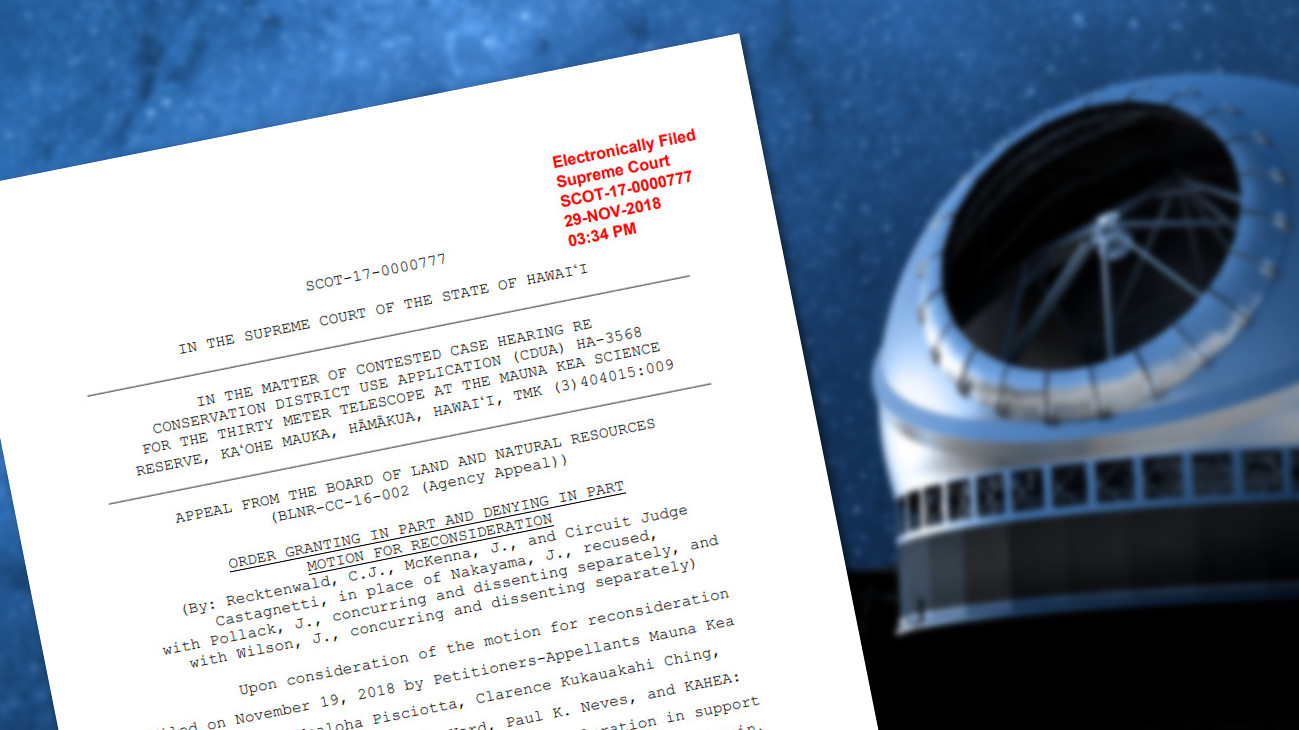(BIVN) – With the exception of changes to some footnotes in the original order, the Hawaiʻi Supreme Court on Thursday denied a motion for reconsideration filed by the petitioners in the case of the Thirty Meter Telescope planned for Mauna Kea.
On October 30, the Hawaiʻi Supreme Court ruled in favor of the state and its approval of a Conservation District Use Permit, paving the way for the $1.4 billion TMT observatory to build on the mountain. Associate Justice Michael Wilson dissented from the majority opinion.
A motion for reconsideration was filed on November 19 by Petitioners-Appellants Mauna Kea Anaina Hou and Kealoha Pisciotta, Clarence Kukauakahi Ching, the Flores-Case ʻOhana, Deborah Ward, Paul Neves, and KAHEA: The Hawaiian Environmental Alliance. The motion for reconsideration was granted, but only in part. The court decided to delete footnote 15, and modify footnote 17. In all other respects, the motion for reconsideration was denied.
Associate Justice Wilson wrote this in dissent:
A central issue of consequence to the parties has therefore understandably been how to apply conservation laws to a resource that has already been degraded by prior land use. The dissent notes that the Majority Opinion does not address the Board of Land and Natural Resource’s (BLNR’s) application of the new principle that prior degradation of cultural resources amounting to a substantial adverse impact means the TMT project cannot have a substantial adverse impact on cultural resources. The Majority now declines reconsideration based in part on a change to footnote 17 affirming that the BLNR’s consideration of “the effect of the project upon cultural practices” included the entire “summit region.” The change constitutes affirmation that the degradation principle applied by the BLNR will affect the cultural resources of the entire “summit region” of Mauna Kea. Thus, all future land uses proposed for the summit of Mauna Kea will be subject to the BLNR’s finding that the summit has already been substantially adversely impacted—specifically that “without the TMT Project, the cumulative effect of astronomical development and other uses in the summit area of Mauna Kea have previously resulted in impacts that are substantial, significant and adverse” and, therefore, “[t]he level of impacts on natural resources within the Astronomy Precinct of the [Mauna Kea Science Reserve] would be substantially the same even in the absence of the TMT Project[.]”
The Hawaiʻi Supreme Court also denied a “Motion for Leave to Appear and File a Brief as Amici Curiae”, also filed on November 19, by Kuaʻāina Ulu ʻAuamo, Colette Y. Machado, and Dan Ahuna. “Due to the unique circumstances of this case,” Associate Justice Wilson wrote that he “would grant the Motion for Leave to Appear and File a Brief as Amicus Curiae.”


by Big Island Video News11:55 pm
on at
STORY SUMMARY
HONOLULU, Hawaiʻi - On Thursday, the high court denied a Motion for Reconsideration as well as a Motion for Leave to Appear and File a Brief as Amici Curiae.